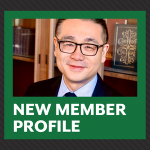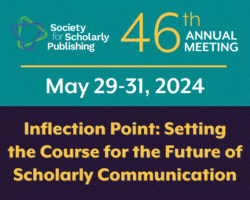Dean and Professor of the College of University Libraries and Learning Services, University of New Mexico
 SSP membership offers a variety of opportunities for professionals across the field of scholarly publishing. In our profiles featuring individuals who have recently joined, learn about the experiences of new members as they spotlight ways to get involved, connect with colleagues, and share knowledge in the industry.
SSP membership offers a variety of opportunities for professionals across the field of scholarly publishing. In our profiles featuring individuals who have recently joined, learn about the experiences of new members as they spotlight ways to get involved, connect with colleagues, and share knowledge in the industry.
Tell us a little about how your career path started and how you got to where you are.
So I did not even know about librarianship as a career when I was younger. I think I discovered it in my 30s. Originally, I was studying film, and I wanted to be a film scholar. And then, somehow, during that program, I got interested in screenwriting. I actually have an MFA in screenwriting. But during that period, I was trying to find direction for what I wanted to do, and one of them was to be a film preservationist or an archivist in that area because I like the history of film and I wanted to preserve film. I started talking to a professor in that area, and he said, “This is really great, and we want more people like you; you can look at our program. But you can also look at library science programs where there are archives and preservation-focused programs.” And when I looked into those programs, I got even more interested in the librarianship part because it was transforming from print to digital, and the search engine and all the stuff about information discovery were really exciting at that time. And I looked more into it and thought, this is actually more fun.
Then I applied to the graduate program at Florida State. I was very fortunate to have gotten an assistantship to work in that library at the main library of the university—that’s really how I got into academic librarianship. After that, I got my first job at Kansas State University and worked there for about five and a half years doing work as a subject librarian, and then I got into assessment, looking at data to tell stories and to make decisions basically. That influenced a lot of the leadership points of view that I have now. Later on, in my department at the University of Alabama, I rose up the ranks, and then to Associate Dean at Penn State University just before this. And then, I got this job as the Dean and Professor of the College of University Libraries and Learning Services at the University of New Mexico. This college is actually a little bit different than everything else because this is a library, but also it has a learning sciences degree program for Bachelors all the way to PhD, and the University Press. So this is scholarly publishing, and that’s why I joined SSP—to learn more about it.
Can you tell us what the work you do now looks like?
As the dean, as I look at it, the main job is to set the direction for the college, which is a unique college, because there are three very different units. It’s also to find resources for the college—bringing in the money, basically. It’s about, first of all, how to demonstrate an argument to the university so that we get funding from the university, and get our donors excited about what can work in the library or the degree program or the press to make an impact, and lay out the vision and see that point of how to align their interests with what we do.
I quite enjoy that, because donors are usually very interesting people. They have very experienced lives and are very successful usually. So I like communicating and chatting with them and learning from them as well. At the same time, I present my vision. And one of the things that we’re doing is open educational resources, which, first of all, are a great way to save money for students. At the same time, it’s a way to change how we teach. This is the part that really gets a lot of people interested, and I keep using it to raise money because the return on investment is so huge. Like right now, we’re doing a couple of pilot projects here. The initial investments are around $20,000. But the return in one year is over $200,000. That will keep going, and I think it will keep working. When we present that kind of return on investment to donors or to the university, they see the impact we’re making, so that helps us with getting more funding. Those are the two things I do that I think I spend the most time on. Primarily setting direction, so we have a strategic plan done. That’s important, to be able to know where we’re heading.
You mentioned that having a press at the university was part of how you got into the scholarly publishing world. Can you say more about that?
So when I worked at Penn State, the university press was also part of the libraries, and the dean basically oversees that, so I got to work with the director a little bit, but not much. So I got a little bit of the taste of it. And also, at Penn State, the library does its publishing. So it’s a different kind of publishing, usually open access, and, you know, working with journal editors and all that, so I got a taste of that as well. And now here, the press is directly under me. So I’m really trying to learn more about the business of the industry, and how it works. I know different universities have different kinds of models. So I’m trying to learn more about that. And that’s why I went to the SSP conference last year in Chicago. I went to several sessions, just to learn about the business, more about the publishing side than the library side. It was really interesting hearing, especially some of the people who started their own businesses or entrepreneurs in this realm. So I’m slowly learning. I’m working closely with the director to explore what are some of the new effects, basically, the direction of the industry, and where university presses are going. That’s what I’m interested in.
What made you decide to join SSP? After attending the Annual Meeting?
Yeah, I joined the association after the conference. I wasn’t a member, but after it, I thought, this is actually quite useful. Because I liked it. I didn’t really talk to a lot of people, but I talked to maybe a couple of people. I thought this is really interesting because it was almost a half-library, half-publishing group, and I like that mix and that you get both points of view. I’m interested in the economics and the business side, actually, very much. And this is a good way for me to learn. That’s why I decided to join the association. I figured that I can attend some webinars and other things, even just talk to people a little bit more. And that’s why I joined.
What do you think is gained by those conversations between people on the publishing side versus the library side?
It’s learning the language a little bit more. Sometimes we come from our own world, and we talk about our perspective, without knowing the other side. It’s always nice to be able to proceed in a mutual common language so we can understand where we’re coming from. It’s always easier to do things together. A lot of things in the libraries I’ve worked in would be beneficial to the world and may now work in some other business model, so it’s about how can we work together on this to make things happen to be mutually beneficial. Open access is one of those. So a common language is what we need to learn more about each other’s perspectives.
How have you found SSP membership so far?
I think it is valuable. I haven’t taken full advantage of it yet because of my own schedule. But I would love to learn more about, for new members, what are some of the good ways to be a little bit more involved and just be more engaged. I have been in library associations for a long time since I feel like the best way is just to get involved, volunteer, and do things where I get to meet people.
SSP members represent the many elements involved in the broad field of scholarly publishing — publishers, e-product developers, librarians, publishing service vendors, editors, and more. Learn about the benefits of joining our community!


